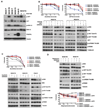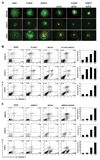Combinatorial treatments that overcome PDGFRβ-driven resistance of melanoma cells to V600EB-RAF inhibition
- PMID: 21803746
- PMCID: PMC3149831
- DOI: 10.1158/0008-5472.CAN-11-0140
Combinatorial treatments that overcome PDGFRβ-driven resistance of melanoma cells to V600EB-RAF inhibition
Abstract
(V600E)B-RAF mutation is found in 50% to 60% of melanomas, and the novel agents PLX4032/vemurafenib and GSK2118436 that inhibit the (V600E)B-RAF kinase achieve a remarkable clinical response rate. However, as might be expected, acquired clinical resistance to these agents arises in most melanoma patients. PLX4032/vemurafenib resistance that arises in vivo in tumor matched short-term cultures or in vitro in melanoma cell lines is not caused by acquisition of secondary mutations in (V600E)B-RAF but rather is caused by upregulating platelet-derived growth factor receptor β (PDGFRβ) or N-RAS which results in resistance or sensitivity to mitogen-activated protein (MAP)/extracellular signal-regulated (ERK; MEK) kinase inhibitors, respectively. In this study, we define a targeted combinatorial strategy to overcome PLX4032/vemurafenib resistance in melanoma cell lines or short-term culture where the resistance is driven by PDGFRβ upregulation, achieving synergistic growth inhibition and cytotoxicity. PDGFRβ-upregulated, PLX4032-resistant (PPRM) cell lines show dual phospho (p)-ERK and p-AKT upregulation, and their growth inhibitory responses to specific small molecule inhibitors correlated with p-ERK, p-AKT, and p-p70S6K levels. Coordinate inhibition of (V600E)B-RAF inhibition and the RTK-PI3K-AKT-mTORC axis led to functionally significant rebound signaling, illustrating a robust and dynamic network connectivity. Combined B-RAF, phosphoinositide 3-kinase (PI3K), and mTORC1/2 inhibition suppressed both immediate early and delayed compensatory signaling, resulting in a highly synergistic growth inhibitory response but less efficient cytotoxic response. In contrast, the combination of MEK1/2, PI3K, and mTORC1/2 inhibitors consistently triggered apoptosis in a highly efficient manner. Together, our findings offer a rational strategy to guide clinical testing in preidentified subsets of patients who relapse during treatment with (V600E)B-RAF inhibitors.
Conflict of interest statement
The authors declare no conflicts of interest.
Figures




Similar articles
-
Melanomas acquire resistance to B-RAF(V600E) inhibition by RTK or N-RAS upregulation.Nature. 2010 Dec 16;468(7326):973-7. doi: 10.1038/nature09626. Epub 2010 Nov 24. Nature. 2010. PMID: 21107323 Free PMC article.
-
Combinations of BRAF, MEK, and PI3K/mTOR inhibitors overcome acquired resistance to the BRAF inhibitor GSK2118436 dabrafenib, mediated by NRAS or MEK mutations.Mol Cancer Ther. 2012 Apr;11(4):909-20. doi: 10.1158/1535-7163.MCT-11-0989. Epub 2012 Mar 2. Mol Cancer Ther. 2012. PMID: 22389471
-
MEK-independent survival of B-RAFV600E melanoma cells selected for resistance to apoptosis induced by the RAF inhibitor PLX4720.Clin Cancer Res. 2011 Feb 15;17(4):721-30. doi: 10.1158/1078-0432.CCR-10-2225. Epub 2010 Nov 18. Clin Cancer Res. 2011. PMID: 21088259
-
Mechanisms of resistance to RAF inhibition in melanomas harboring a BRAF mutation.Am Soc Clin Oncol Educ Book. 2013. doi: 10.14694/EdBook_AM.2013.33.e80. Am Soc Clin Oncol Educ Book. 2013. PMID: 23714462 Review.
-
Ras/Raf/MEK/ERK and PI3K/PTEN/Akt/mTOR cascade inhibitors: how mutations can result in therapy resistance and how to overcome resistance.Oncotarget. 2012 Oct;3(10):1068-111. doi: 10.18632/oncotarget.659. Oncotarget. 2012. PMID: 23085539 Free PMC article. Review.
Cited by
-
Concomitant BRAF and PI3K/mTOR blockade is required for effective treatment of BRAF(V600E) colorectal cancer.Clin Cancer Res. 2013 May 15;19(10):2688-98. doi: 10.1158/1078-0432.CCR-12-2556. Epub 2013 Apr 2. Clin Cancer Res. 2013. PMID: 23549875 Free PMC article.
-
Stat3-targeted therapies overcome the acquired resistance to vemurafenib in melanomas.J Invest Dermatol. 2013 Aug;133(8):2041-9. doi: 10.1038/jid.2013.32. Epub 2013 Jan 23. J Invest Dermatol. 2013. PMID: 23344460 Free PMC article.
-
Topical 2'-Hydroxyflavanone for Cutaneous Melanoma.Cancers (Basel). 2019 Oct 14;11(10):1556. doi: 10.3390/cancers11101556. Cancers (Basel). 2019. PMID: 31615091 Free PMC article.
-
Integrin-Src-YAP1 signaling mediates the melanoma acquired resistance to MAPK and PI3K/mTOR dual targeted therapy.Mol Biomed. 2020 Nov 10;1(1):12. doi: 10.1186/s43556-020-00013-0. Mol Biomed. 2020. PMID: 35006410 Free PMC article.
-
Differential activity of MEK and ERK inhibitors in BRAF inhibitor resistant melanoma.Mol Oncol. 2014 May;8(3):544-54. doi: 10.1016/j.molonc.2014.01.003. Epub 2014 Jan 15. Mol Oncol. 2014. PMID: 24476679 Free PMC article.
References
Publication types
MeSH terms
Substances
Grants and funding
LinkOut - more resources
Full Text Sources
Other Literature Sources
Medical
Research Materials
Miscellaneous

